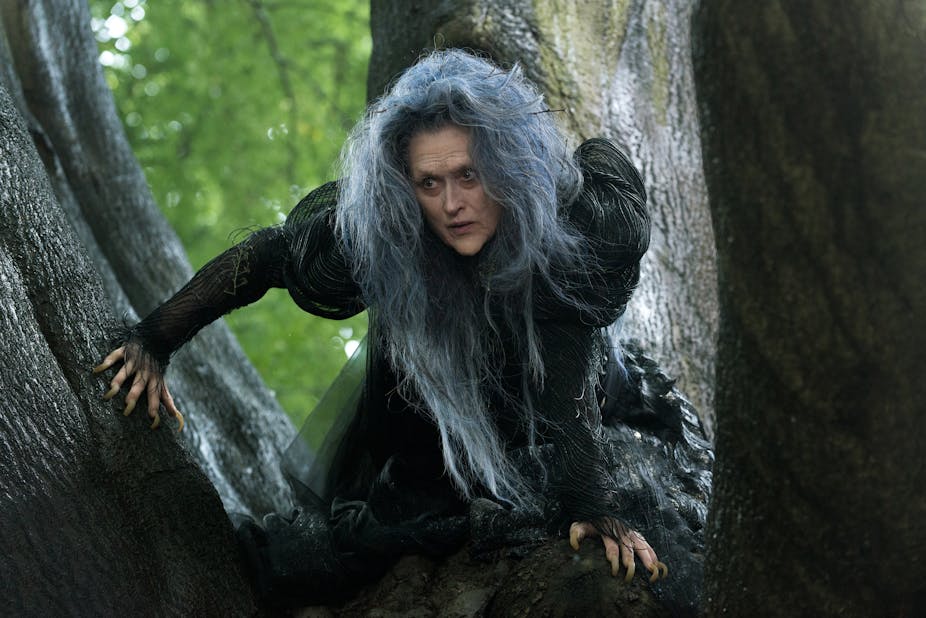Fairy tales have happy endings. They may be dark and scary but the prince always finds Cinderella and Little Red Riding Hood susses out the big bad wolf. Right? All too often many assume that fairy stories are, have always been and should be all about the happily ever after.
The release of Into the Woods has set this myth on its bewitching way once again. The film is a Disney adaptation of Stephen Sondheim’s musical intertwining of several well-known fairy tales, principally Little Red Riding Hood, Jack and the Beanstalk, Rapunzel, and Cinderella, and features more death than the typical tale, and other “adult themes” like adultery. Predictably, its release has set the worriers worrying that Disney’s version will have sugar-spun the original beyond all recognition.
And the film has had a rather mixed reception from the reviewers. Some see it as a “mulched”, “mythic mash-up” that “loses clarity”, while others have described it as “pure pleasure”. Predictably, Radio 4’s Today programme raised the concern that because Into the Woods has been created for families (and by Disney) it will be saccharine with the “adult themes” lost. And yet adult themes of loss of innocence, poverty, greed, desire, love and despair have always been integral to the fairy story.

Dark beginnings
Fairy tales started as a spoken tradition and were written up by the Grimm Brothers and Charles Perrault for families – not exclusively for children. What’s more, they contained predatory wolves who had to be killed, children who were abandoned and wicked, and wayward witches. Jack Zipes demonstrates in his study of Red Riding Hood that often in early versions the endings of the story weren’t so very happy and included our red-capped heroine sometimes defeating the wolf single handed, and in others being eaten all up. As Angela Carter showed us, these dark cautionary tales for young women were passed down by mothers and grandmothers for good reason. The stories functioned as warnings, life lessons about growing up as a woman.
Interestingly, it’s gender stereotypes that offend most cultural theorists such as Henry Giroux, who accuse the animated versions of fairy stories in particular of being full of outdated ideology. Certainly, early Disney didn’t alter the blueprint of the early fairy tales – rags to riches, a happy ending, defeating the baddies – but it is far from cautious in confronting so-called adult themes such as death, jealousy and fear of responsibility.
Scarily, the versions I have found most conservative in terms of ideology are actually educational animations of fairy stories made for schools. They rather alarmingly reduce girls to sappy, hapless victims who should never be sent into the woods at all. The much loved Frozen meanwhile has sister rescuing sister, a much more innovative reworking of fairy tale traditions.
A patchwork quilt of reinvention
Disney is not alone in its fascination with fairy stories. As any fan of the children’s picture book will tell you, there are numerous retellings which hold up a magic mirror to our shared experiences, turning gender stereotypes along with many other conventions on their heads.
Into the Forest by Anthony Browne is an entrancing picture book which captures the eerie qualities of the forest and invites us to spot familiar fairytale characters lurking in the background. In Janet and Alan Ahlberg’s Each Peach Pear Plum the rhyming story also features fairy tale and nursery rhyme characters up to their usual and not-so-usual tricks. Similarly, The Jolly Postman shares hilarious everyday backstories for Goldilocks and Cinders which are revealed in the letters, mail order catalogues and invitations the characters send each other.
And beyond compare perhaps in this genre, the Shrek films have fun with all the rules and conventions of fairy stories, including those of Disney. The brilliance of ogre Fiona outweighs the overbearing godmother, who is to blame for most of the misdemeanours.

Far from being safe and essentially conservative, the continued renewal of the fairy story through each retelling has pushed all the boundaries of taste and traversed the shades of light and dark in surprisingly exhilarating ways. In Roald Dahl’s Revolting Rhymes, Red Riding Hood whips a pistol from her knickers. More recently in Hoodwinked, a rather under-rated film, Red is a feisty sleuth whose competence and bravery are at the heart of the film and it is granny (plot spoiler) who is badly behaved.
So perhaps in Into the Woods we should anticipate Emily Blunt’s apparently rather good singing, Meryl Streep’s wicked witch and a prince who decamps camp (if the reviews prove good) with a more open mind.
Fairy tales are a uniquely adaptable and adapted form which continue to be renewed and transformed for new family audiences. For children today, the woods are an important imaginative realm, somewhere where the baddies can be good and goodies can be bad. We have to continue to invite our children into the fictional forests, to learn about the dangerous and wonderful world through the lens of fantasy.
So before we get to go into the woods we should take care not to get too comfortable in the cosiness of the cottage fireside – and remember the dark truth in the history of the fairy tale and the continued possibility of invention, innovation, subversion and disruption.

